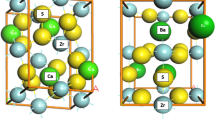Abstract
Clusters of corundum including from 4 to 14 AlO6 octahedrons have been calculated by the MINDO/3 and CNDO/2 methods. The influence of various boundary conditions on the electronic structure of fragments of the oxide has been investigated. The quasi-band structure of the clusters has been examined on the basis of calculations of the integral, orbital, and local densities of their electronic states. The electronic structure of clusters with point defects, viz., anion and cation vacancies, has been studied, and the dependence of the combined density of states, which determines the imaginary part of the dielectric constant, on the nature of the defects has been demonstrated. Small fragments of aluminum oxide have been calculated by a nonempirical method in the STO-3G basis. The general tendencies in the variation of the quasi-band structure of clusters with different boundaries for the semiempirical and nonempirical methods have been demonstrated.
Similar content being viewed by others
Literature cited
R. A. Evarestov, E. A. Kotomin, and A. N. Ermoshkin, Molecular Models of Point Defects in Broad-Gap Solids [in Russian], Zinatne, Riga (1983).
J. A. Tossell, “The electronic structure of Mg, Al, and Si in octahedral coordination with oxygen from SCF-Xα -MO calculation,” J. Phys. Chem. Solids,36, No. 11, 1273–1280 (1975).
B. K. Vainshtein, V. M. Fridkin, and V. L. Indenbom, Modern Crystallography [in Russian], Vol. 2, Nauka, Moscow (1979).
P. Yu. Dikov, I. A. Brytov, Yu. N. Romashchenko, and S. P. Dolin, Features of the Electronic Structure of Silicates [in Russian], Nauka, Moscow (1979).
D. R. Salahub and R. P. Messmer, “Molecular-orbital study of aluminum clusters containing up to 43 atoms,” Phys. Rev., B,16, No. 6, 2526–2537 (1966).
V. M. Gun'ko and L. M. Roev, “Calculations of the densities of the electronic states of aluminum oxide clusters,” Teor. Éksp. Khim.,20, No. 3, 298–305 (1984).
F. Bassani and G. Pastori Parravicini, Electronic States and Optical Transitions in Solids, Pergamon Press, New York (1975).
V. A. Korsunov, F. Riechl, N. D. Chuvylkin, and V. B. Kazanskii, “Cluster realization of single-configuration schemes for the analysis of the energies of electronic excitations in surface complexes on oxides,” Zh. Fiz, Khim.,57, No. 5, 1133–1136 (1983).
Author information
Authors and Affiliations
Additional information
Translated from Teoreticheskaya i Éksperimental'naya Khimiya, Vol. 21, No. 6, pp. 651–659, November–December, 1985.
Rights and permissions
About this article
Cite this article
Gun'ko, V.M. Quantum-chemical investigation of α-Al2O3 in the molecular-cluster approximation. Theor Exp Chem 21, 621–629 (1985). https://doi.org/10.1007/BF00945137
Received:
Issue Date:
DOI: https://doi.org/10.1007/BF00945137




